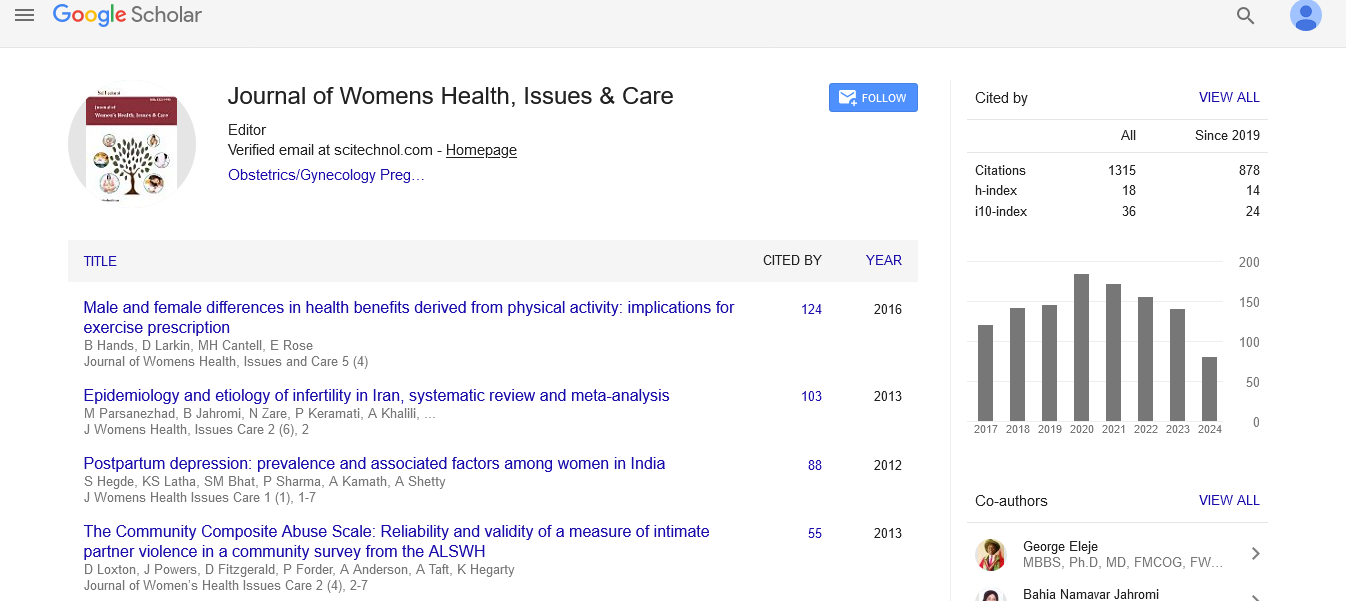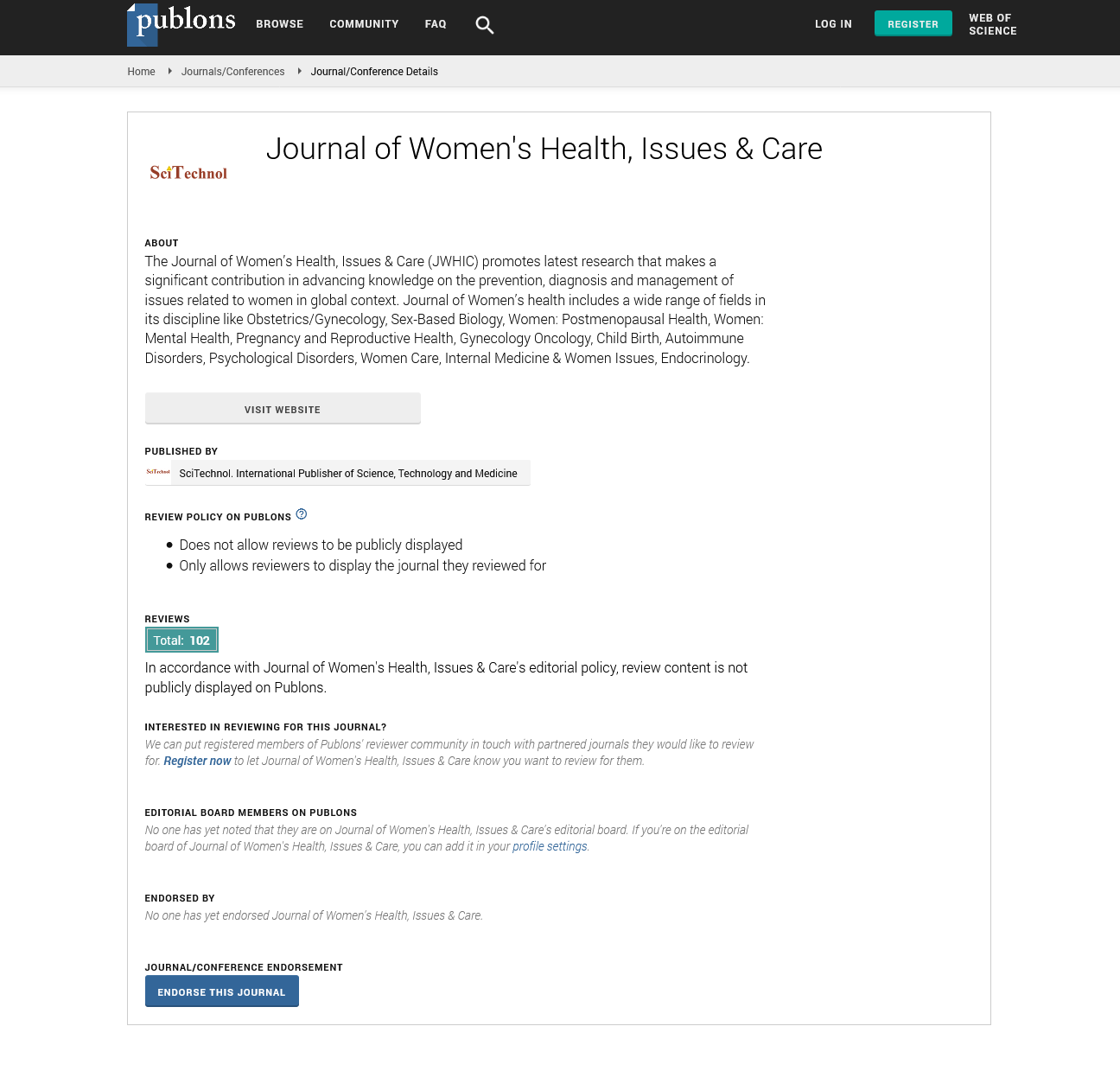Opinion Article, J Womens Health Vol: 13 Issue: 3
Empowering Women's Pelvic Health: Insights into Urogynecology Disorders and Care Strategies
Yeing Kyu*
1Department of Obstetrics and Gynecology, Seoul National University College of Medicine, Seoul, Republic of Korea
*Corresponding Author: Yeing Kyu,
Department of Obstetrics and Gynecology,
Seoul National University College of Medicine, Seoul, Republic of Korea
E-mail: kyuyeing@edu.kr
Received date: 31 May, 2024, Manuscript No. JWHIC-24-140057;
Editor assigned date: 03 June, 2024, PreQC No. JWHIC-24-140057 (PQ);
Reviewed date: 18 June, 2024, QC No. JWHIC-24-140057;
Revised date: 26 June, 2024, Manuscript No. JWHIC-24-140057 (R);
Published date: 04 July, 2024 DOI: 10.4172/2325-9795.1000505.
Citation: Kyu Y (2024) Empowering Women's Pelvic Health: Insights into Urogynecology Disorders and Care Strategies. J Womens Health 13:3.
Description
Urogynecology disorders encompass a range of conditions affecting the pelvic floor in women, impacting quality of life and overall wellbeing. These disorders include pelvic organ prolapse, urinary incontinence, and fecal incontinence, among others. Understanding their causes, symptoms, and treatments is necessary for effective management and improved outcomes.
Common urogynecology disorders
Urinary incontinence, characterized by involuntary urine leakage, affects millions of women worldwide. Stress Urinary Incontinence (SUI) occurs during activities like coughing or exercising due to weakened pelvic floor muscles. Urge Urinary Incontinence (UUI) involves sudden, intense urges to urinate. Its main causes include in pregnancy and childbirth, menopause, obesity, and neurological conditions can contribute to urinary incontinence. Changes in hormone levels and pelvic floor muscle weakness are common underlying factors. Treatment options range from lifestyle modifications and pelvic floor exercises to medications and surgical interventions like sling procedures or bladder neck suspension.
Pelvic organ prolapse
Pelvic organ prolapse occurs when pelvic organs such as the bladder, uterus, or rectum descend into the vaginal space due to weakened pelvic floor muscles and ligaments. Risk factors include childbirth, aging, obesity, and chronic constipation. Symptoms vary but commonly include pelvic pressure, discomfort, and in severe cases, bulging tissue through the vaginal opening. Treatment options range from pelvic floor exercises and pessaries to surgical interventions aimed at restoring pelvic support.
Urinary incontinence
Urinary incontinence, a prevalent urogynecological issue, involves involuntary urine leakage. Types include stress incontinence (leakage during physical activity or exertion), urge incontinence (sudden urge to urinate followed by leakage), and mixed incontinence (combination of both). Causes include weakened pelvic muscles, nerve damage, and hormonal changes. Treatment may involve behavioral modifications, pelvic floor rehabilitation, medications, or surgical procedures tailored to the specific type and severity of incontinence.
Impact on quality of life
Urogynecology disorders significantly affect women's quality of life, influencing physical, emotional, and social well-being. Many women experience embarrassment, social isolation, and psychological distress due to symptoms such as incontinence or pelvic discomfort. Addressing these disorders comprehensively is essential for restoring confidence and overall health.
Diagnosis and management
Diagnosis often involves a thorough medical history, physical examination, and diagnostic tests such as urodynamic studies or imaging techniques. Management strategies focus on symptom relief, preservation of pelvic floor function, and improvement of bladder and bowel control. Patient-centered care, including education on pelvic health, lifestyle modifications, and personalized treatment plans, is integral to successful management.
Challenges and future directions
Challenges in urogynecology care include underreporting of symptoms due to stigma, delayed diagnosis, and variability in treatment outcomes. Future directions include advancing minimally invasive surgical techniques, enhancing patient education and awareness, and promoting interdisciplinary approaches involving urologists, gynecologists, and pelvic floor specialists. Research into biomarkers, genetic predispositions, and personalized medicine holds promise for tailored therapies.
Conclusion
Urogynecology disorders in women pose significant health challenges, impacting physical comfort, emotional well-being, and overall quality of life. By understanding the complexities of these conditions, promoting early diagnosis, and implementing comprehensive treatment strategies, healthcare providers can improve outcomes and empower women to manage and overcome urogynecological issues effectively. Continued research and advocacy are essential to advancing care and supporting women's pelvic health across the lifespan.
 Spanish
Spanish  Chinese
Chinese  Russian
Russian  German
German  French
French  Japanese
Japanese  Portuguese
Portuguese  Hindi
Hindi 



